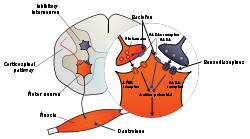Hypertonia
Hypertonia is an increased muscle tone, which occur in a lesion of upper motor neuron (central lesion). People who suffer from hypertonia have their limbs stiff and every movement is very difficult for them. Althought it is mainly a lesion of pyramidal tract, motor neurons and muscles, it affects secondarily also joints and a joint contracture occurs. It is very important to prevent them by physical therapy of drugs prescription, or subsequently we have to proceed to surgery. If not, people are threatened by immobility.
Patogenesis[edit | edit source]
The main problem is an imbalance between the function of a pyramidal tract (leads the information from the brain to the muscles, that they should contract) and the function of an extrapyramidal tract (inhibition of the muscle contraction). γ-motorneurons, which are normally inhibited by the extrapyramidal tract, start to be hyperfunctional and muscle tone rises (hypertonia). In rigidity it is a hyperfunction of α-motorneurons.
The main inhibitory neurotrasmitter is GABA and main excitatory neurotrasmitter is glutamate (see picture).
Types of Hypertonia[edit | edit source]
Spasticity[edit | edit source]
A type of hypertonia where is a muscle resistance to passive movements present (the more we stretch a muscle, the greater resistance occurs). Mainly affected are antagonists of the movement. The resistance is not continuous, so if we reach the turning point, the spasticity disappears – so called "clasp-knife phenomenon"
Rigidity[edit | edit source]
Rigidity is an affection of agonists and also antagonists muscles, which work against each other. It is typical for basal ganglia´s diseases (e.g.:Parkinson´s disease). More affected are flexors and axial muscles, what leads to very specific body posture (bent on like). The resistance to the movements is continuous and sometimes it is compared to "the movement of lead pipe". Froment´s phenomenon – rigidity becames more visible if we ask patient to move his second limb.
Etiology[edit | edit source]
The etiology of hypertonia is pretty variable. It can be cause by some brain trauma, tumors, neurodegenerative diseases (Parkinson´s disease, multiple sclerosis), stroke or some toxins.
Therapy[edit | edit source]
Nowadays the most common treatment of the hyperonia are medicaments, especially muscle relaxing ones (baclogen, dandrolen). Dantrolen is special in its dosage, because we can also aplicate it into the cerebrospinal fluid in a spinal canal. This special dandrolen pump continuously adjusts the dose throughout the day.
Another option is botulin toxin, althought it can be injected just to a specific location and its influence is just locally. Botulin usually helps for 3 months. More frequent doses have no significance, because the tolerance of a body is increasing (thanks to production of antibodies).
The physical therapy is also usefull and people with hypertonia should do many exercise, which can help them to preserve as many movements as possible.
Links[edit | edit source]
Related articles[edit | edit source]
- Motor Neurons
- Motorneuron Diseases
- Basal Ganglia
- Cerebrospinal Fluid
- Neurotrasmitters
- Parkinson´s Disease
- Multiple Sclerosis
External links[edit | edit source]
Bibliography[edit | edit source]
- AMBLER,. Základy neurologie. 7th edition. 2011. ISBN 978-80-7262-707-3.
- JEDLIČKA, KELLER,, et al. Speciální neurologie. 1st edition. 2005. ISBN 80-7262-312-5.


